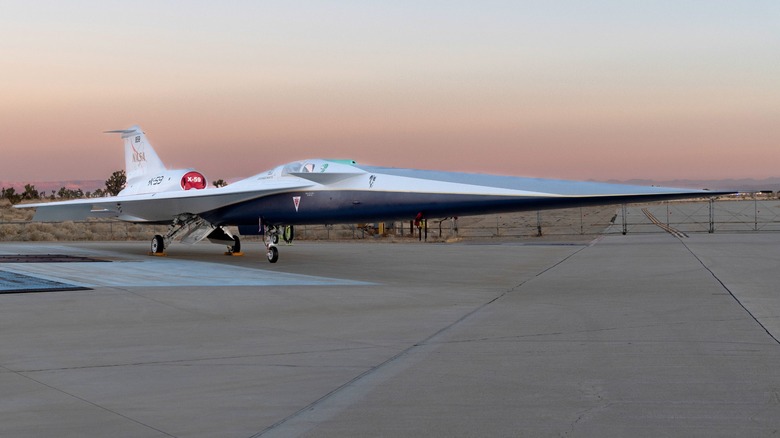NASA X-59 Top Speed: How Fast Can The Supersonic Jet Travel?
The Lockheed Martin X-59 Quesst, which stands for "Quiet SuperSonic Technology," is an experimental aircraft developed by Lockheed's legendary Skunk Works. That's the same organization that developed the SR-71 Blackbird, and now it's working with NASA on its Low Boom Flight Demonstrator project. The aircraft has a unique design and is meant to cruise at Mach 1.4 (925 mph) at an altitude of 55,000 feet.
Its design should theoretically reduce its effective perceived noise level (EPNdB), making the supersonic aircraft much quieter than previous vehicles. Usually, when an aircraft breaks the sound barrier, it generates a sonic boom. NASA hopes to design an aircraft capable of supersonic flight over land with acceptable noise levels, ideally reducing the sound generated by a sonic boom to a noise barely audible on the ground. If the technology proves capable, it could open the door for commercial supersonic flights without worrying about shattering car windows or other nuisances brought on by the loud sonic booms.
Previously, aircraft like the famed Concorde carried passengers across the Atlantic, but couldn't fly over land because of the sound they generated. If successful, the X-59 could offer an alternative. This is the first purpose-built X-aircraft NASA has developed in years, and while speed is a factor, it's not designed to break airspeed records. Still, it's not slow by any measure, as Mach 1.4 is a speed that's primarily limited to some military strategic jet bombers in operation, as well as various fighter jets.
How the X-59 Quesst's design could change air travel as we know it
Lockheed Martin's X-59 Quesst is a considerably large aircraft. It stretches nearly 100 feet long with a relatively short wingspan of just under 30 feet. It's powered by a General Electric F414 engine, the same one used in the F/A-18 Super Hornet, which gives it a theoretical maximum speed of Mach 1.5 (990 mph). An unusual aspect of the aircraft's design is its elongated nosecone, which completely obstructs the pilot's forward vision. To compensate, the X-59 is outfitted with an enhanced flight vision system that uses a 4K camera to deliver the forward imagery to the pilot.
The X-59's long, narrow airframe and canards ensure air moves in just the right way to stop the X-59 from generating a loud sonic boom during supersonic travel. Ideally, the X-59's sonic boom would produce a sound no greater than 75 EPNdB on the ground, roughly equivalent to the sound of a car door slamming shut a few houses away. That's ridiculously quiet even compared to commercial aircraft, many of which generate anywhere between 82 and 103 EPNdB.
It's also much quieter than the Concorde, whose noise output was as high as 119.5 EPNdB. If the X-59 can indeed reduce its noise by 44.5 EPNdB, it will truly be a game-changer for supersonic aircraft. Ultimately, the X-59 is one step toward improving aircraft design for supersonic travel, and it seems that NASA and Skunk Works are well on their way to achieving their goal.

